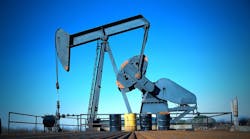Marilyn Radler
OGJ Senior Editor-Economics
HOUSTON, June 15 -- US oil and natural gas reserves increases last year for a group of top producers reached a 5-year high, reported Ernst & Young LLP.
In its fourth annual benchmark study, E&Y analyzed the 2010 results of the 50 largest companies with US oil and gas operations based on their yearend reserves estimates. The list includes some companies with headquarters outside the US and includes activity related to XTO Energy Inc., which was acquired by ExxonMobil Corp. during 2010.
The report found that the group’s yearend 2010 oil reserves were 17.8 billion bbl, up 11% from a year earlier, and gas reserves totaled 174.3 tcf, up 12%, as a result of strong shale gas development.
Technological advances enabled increased shale oil and gas development and sharp increases in reserves or production replacement rates, E&Y said. The oil production replacement rate from all sources, including extensions and discoveries, improved recovery, revisions, purchases, and sales of proved reserves in 2010 was 234%. The all-sources gas production replacement rate last year was 252%.
Production replacement rates, excluding purchases and sales, also were strong in 2010 at 205% for oil and 249% for gas.
Reserves replacement costs on a total basis, including proved property acquisitions, increased to $15.26/boe in 2010 from $12.78/boe a year earlier. Reserves replacement costs on a finding and development basis, excluding proved property acquisitions, increased to $17.84/boe, up from $13.01/boe a year earlier, according to the report.
Oil prices generally traded at $70-80/bbl for most of 2010, said Marcela Donadio, Americas oil and gas leader for E&Y. “And while natural gas prices were weak, they were stable in 2010. This created a healthy environment for investing in finding reserves and the technology for producing them. Stability in price—in spite of an uncertain regulatory environment—made reserve replacement and growth possible,” Donadia said.
Capital spending, revenue
The study also found that total upstream spending by the group of 50 companies, including exploration, development, and acquisitions of proved and unproved properties, more than doubled in 2010 to $177.9 billion from $72.8 billion a year earlier.
E&Y said ExxonMobil’s acquisition of XTO Energy accounted for 51% of proved property acquisition costs and 40% of unproved property acquisition costs in 2010, while Apache Corp.’s acquisitions of Mariner Energy Inc. and certain Devon Energy Corp. and BP PLC assets also contributed significantly to proved and unproved property acquisition costs. Other major contributors to the increases in acquisitions included Denbury Resources Inc. and Chesapeake Energy Corp.
Capital spending for exploration was up 8% in 2010, while development spending increased 36%, primarily due to shale development, both for gas and oil. Combined, the increase in exploration and development spending was primarily driven by ExxonMobil, Chesapeake Energy, and EOG Resources Inc.
Only four of the companies in the study reported decreases in their combined exploration and development spending in 2010, including BP, ConocoPhillips, Plains Exploration & Production Co., and Loews Corp.
Upstream revenues for the 50 companies increased 19% from 2009 to $143.8 billion in 2010, driven by higher oil and gas prices. Upstream revenues averaged $43.82/boe in 2010, up from $37.09/boe a year earlier.
Production costs rose 10% last year to $39.1 billion, averaging $11.90/boe compared with the 2009 average of $10.91/boe. Lease operating expenses increased 5% in 2010 and production taxes were up 27%, the study said.
Contact Marilyn Radler at [email protected].

